What is a robot vacuum cleaner?
Do you know that every third vacuum cleaner that is bought in Spain is a robot vacuum cleaner? Demand in Russia for these devices is also growing from month to month. Prices range from an average of 10,000 to 30,000 rubles. What is this popular gadget and how is it arranged? We will answer these questions in this article. We put on the operating table a robot vacuum cleaner of the middle price range Yujin Robot iClebo Arte and begin to study its insides. It sounds creepy, but I assure you, the article is suitable even for 0+ readers.
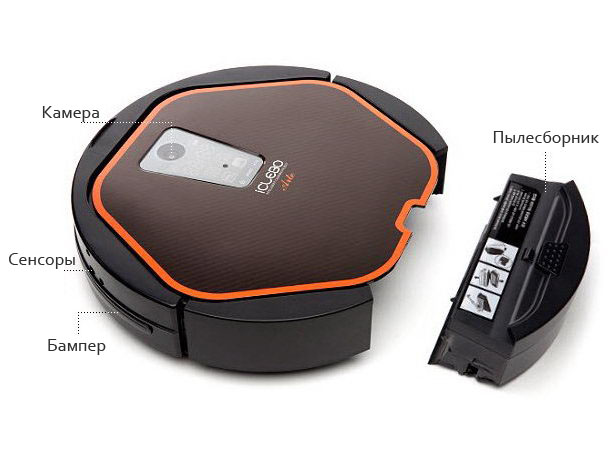
 A camera is located on the upper part of the case, it helps to build a map of the room, and lets the robot know where it was already and where it has not yet been cleaned. Also, with its help, the robot finds the shortest path from the end of cleaning to the start place (base for recharging). In the photo you can see the LCD touch screen with control buttons and icons, a bumper with a set of sensors, a dust collector. IR distance sensors are located on the bumper, with their help the robot “sees” obstacles and tries not to touch them. Sensors are not located on the entire surface of the bumper, therefore, bumping into an obstacle at an angle, the robot touches it, and then I trigger mechanical collision sensors. In this case, the vacuum cleaner changes its direction according to a given motion algorithm. IClebo has an optional fourth sensor at the very top of the bumper. With it, the robot determines the ability to drive under the furniture and not get stuck. The dust collector is removed by pressing a button on the housing and does not have any dust bags, as well as no electromechanical parts. The dust collector and filter can be washed under water. The suction mechanism is located directly inside the robot.
A camera is located on the upper part of the case, it helps to build a map of the room, and lets the robot know where it was already and where it has not yet been cleaned. Also, with its help, the robot finds the shortest path from the end of cleaning to the start place (base for recharging). In the photo you can see the LCD touch screen with control buttons and icons, a bumper with a set of sensors, a dust collector. IR distance sensors are located on the bumper, with their help the robot “sees” obstacles and tries not to touch them. Sensors are not located on the entire surface of the bumper, therefore, bumping into an obstacle at an angle, the robot touches it, and then I trigger mechanical collision sensors. In this case, the vacuum cleaner changes its direction according to a given motion algorithm. IClebo has an optional fourth sensor at the very top of the bumper. With it, the robot determines the ability to drive under the furniture and not get stuck. The dust collector is removed by pressing a button on the housing and does not have any dust bags, as well as no electromechanical parts. The dust collector and filter can be washed under water. The suction mechanism is located directly inside the robot.

Turn the robot cleaner over. Two leading side wheels set the movement of the device, the front small auxiliary wheel without a drive. A special magnetic sensor is located on its axis. It is necessary to measure the distance traveled by the robot. The wheel does not rotate around its horizontal axis, this is not necessary. The robot changes its direction in place by transmitting torque to one of the side wheels, that is, it does not affect maneuverability.
Under a small plastic cover is a 2200 mAh Li-Ion battery. This sample has two side brushes, from a practical point of view this helps to capture a large area in one passage. In order to get to the baseboard, just one side brush is enough, not a single robot vacuum cleaner reaches the corners completely yet. Two side brushes direct debris to the main turbo brush, which in turn directs it to the dust collector. The suction module helps suck out the debris from the turbo brush. A rubber scraper located on the dust collector picks up large debris. According to this principle, all robotic vacuum cleaners are designed in view of the absence of a large suction force. The result of cleaning on smooth floors with this design is very good, on carpets - worse, the robot can not suck out dust from the villi.
Near the dust collector you can see two indentations - grooves for the floor polisher. This vacuum cleaner has a mopping function. The base of the mop is attached to the bottom, the robot both vacuums and wipes. A microfiber cloth can be dampened with water before starting. In the process, it will not be possible to wet it, the robot discards the room map and the current cleaning program when it is torn off the floor. The napkin helps to collect fine dust, including flour, fine sand, salt. For a full floor cleaning, it will not work.

It's time to take up the tools and see how the robot vacuum cleaner looks from the inside. We take out the dust collector and the main turbo brush. We put the robot vacuum cleaner on the front panel and see 5 holes for the bolts. The sixth hole is under the seal sticker labeled QC Passed.
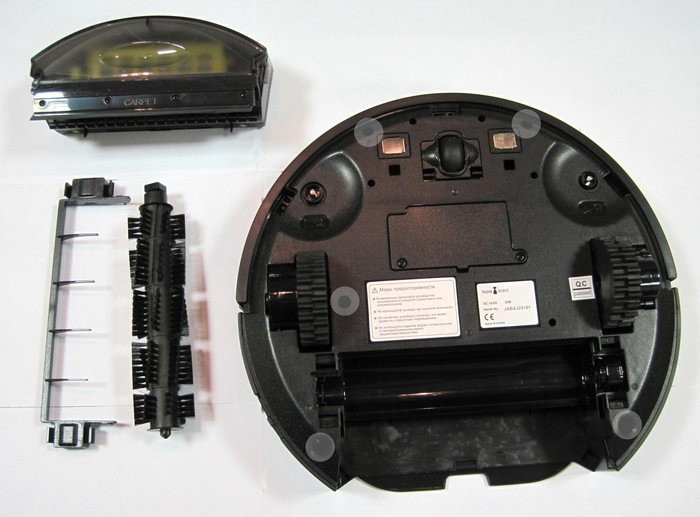
Next, you need to carefully disconnect the ends of the bumper. In this case, special difficulties should not arise, the plastic is sufficiently elastic and strong.
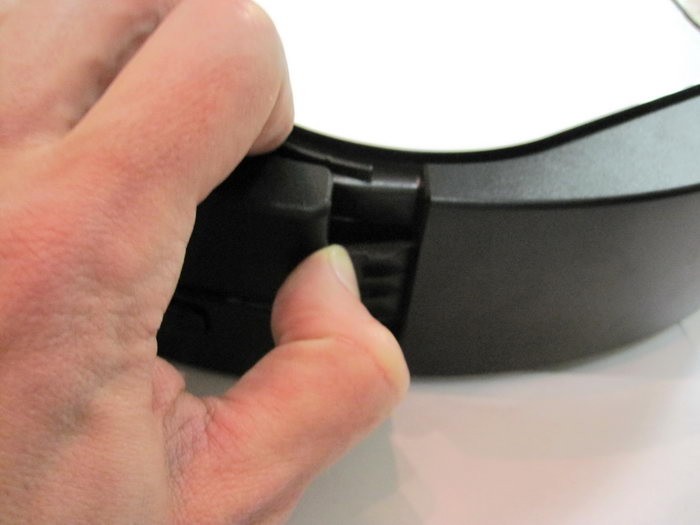
With iClebo facing the ceiling, we extend the decorative panel of the robot. To do this, pull the edge of the panel toward you and up. So we got access to the filling of the robot vacuum cleaner.
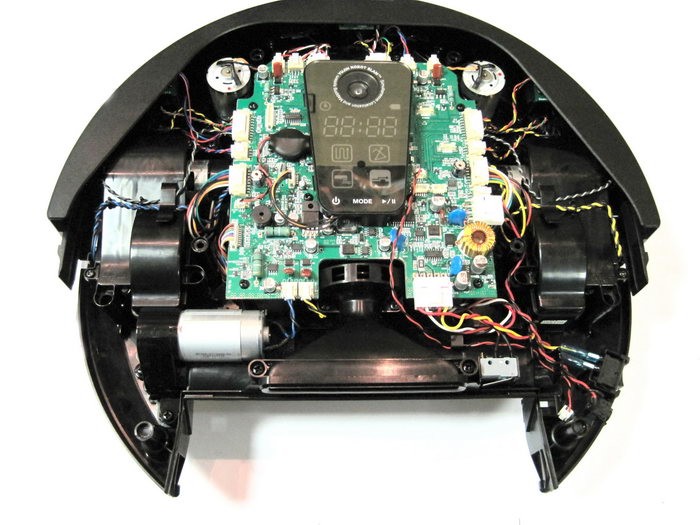
With the naked eye you can discern the main elements. The robot has 6 electric drives: two for the side brushes, one for the turbo brush, one for the suction module (hidden under a plastic casing), two are built into the side wheel housing. To the right under the LCD screen of the robot vacuum cleaner is its “brain” - the Abov MC81F4216D microcontroller. A special sensor is located next to the motherboard and the dust collector installation site. When it closes, iClebo “understands” that the dust collector is connected, otherwise the robot cleaner will not budge and will display an error on the display.
We remove the LCD screen. We see the camera, an infrared receiver under it. In the center are the LEDs for the screen.
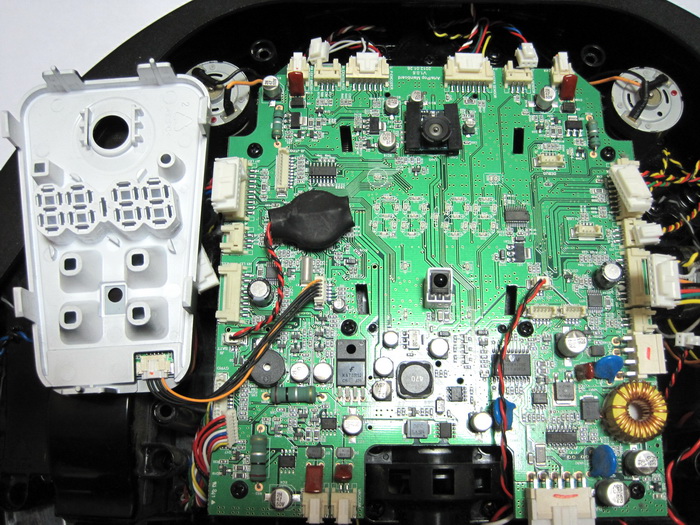
We free the motherboard from many contacts and see the gyroscope, which is needed to determine the angle of rotation of the robot.
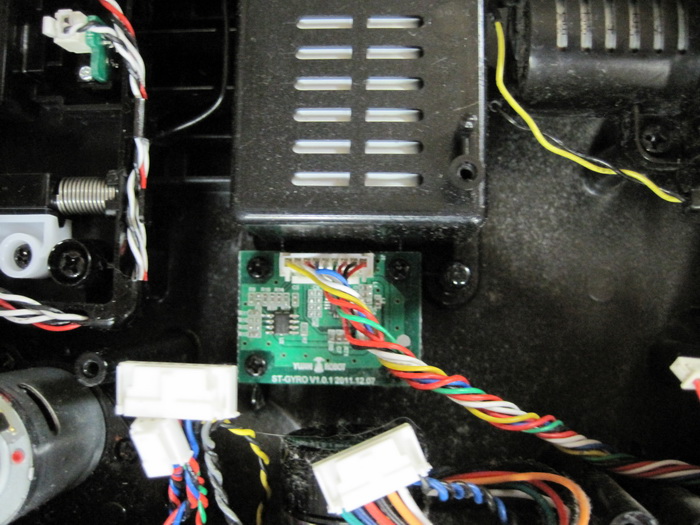
And finally, we will free the motherboard itself from all contacts.
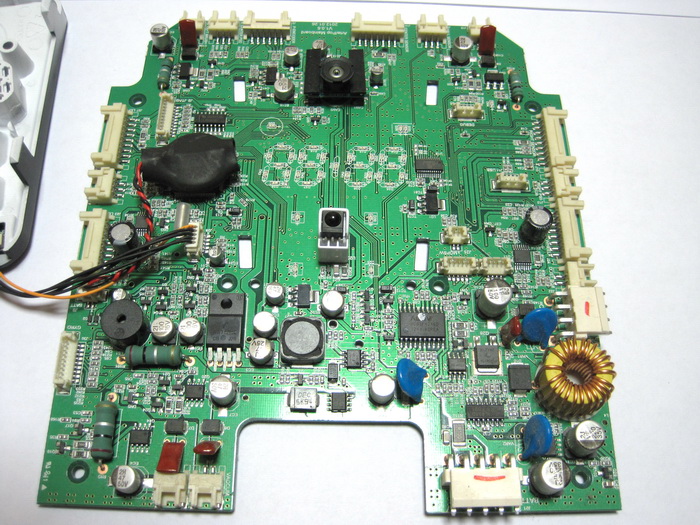
What is such a device as a robot vacuum cleaner. The block diagram of the device is presented below:
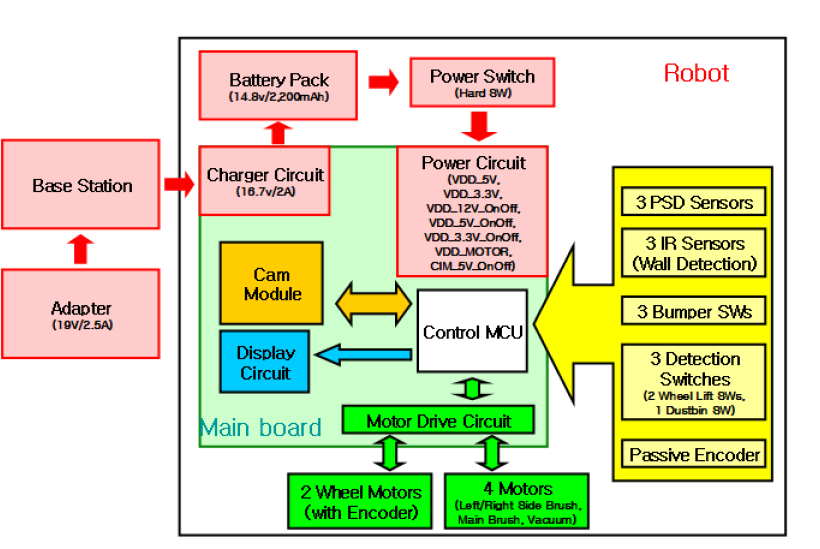
We have a motherboard (Main board) with a camera module, a display, a control module for electric drives of the side wheels, etc. The 19-volt adapter, through the base for charging the robot, charges a lithium-ion battery that powers all other elements of the circuit. For the clock and timer, an additional tablet battery is used on the motherboard. Three height difference sensors (3 PSD Sensors) are located at the bottom of the device. Three infrared sensors (3 IR Sensors) are located directly on the bumper itself. When an obstacle is detected, the robot cleaner changes direction. If the IR sensor does not work, but the robot still runs into an obstacle, the mechanical bumper sensor (3 Bumper SWs) is triggered. The diagram also shows 3 Detection Switches - two sensors determine whether the wheels are off the floor, and the third is a dust bag. Passive Encoder - a sensor located near the front axle of the wheel to determine the distance traveled.
In order to understand where the robot has already been cleaned, and where not yet, it receives information from all of the above sensors and sensors. He measures the distance traveled and the angle of rotation, and with the help of a camera and obstacle sensors he "understands" where the boundaries of the area being cleaned are. Future home robotic vacuum cleaners will use cameras to fully map the room, determine the presence of people and animals in the room and, most likely, it will be possible to indicate with a gesture to the robot its further actions or change the operating mode.
It remains to deal with the wheels. Remove the side wheel. A sensor on the side of the wheel helps the robot determine its position in space, namely: is it standing on the floor? If the contact is open, the robot stops working.

Having disassembled the wheel housing, we see here such a gearbox.

Of course, all these components are controlled by software, and without correctly written program code, the robot will not function. This vacuum cleaner has the ability to update software, but only experienced users will be able to do this, since a programmer is required to flash the “brains” of the vacuum cleaner. The ST-Link programmer is used. The main part of the robot firmware is carried out using this adapter, through the J2 JTAG connector on the board, and only the navigation module is updated via J11 USB. Moreover, both parts of the firmware are interconnected.
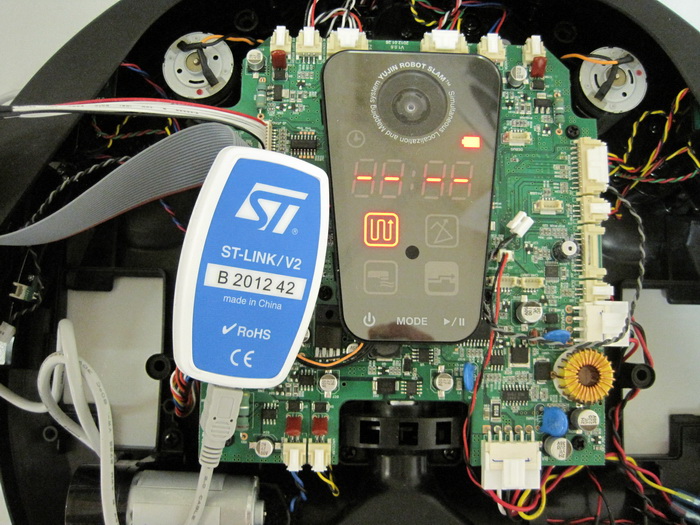
A robot vacuum cleaner is a complex technical device and the prices are relatively high, especially when compared with household vacuum cleaners for 3,000 rubles. It is likely that when the robot can manage with a pair of cameras to perform all navigational actions, the cost of production will drop markedly, and therefore the final cost of the device. In the meantime, buyers pay mostly for convenience: we set a timer, go to work, the robot cleans in your absence and automatically returns to the base. Well, and of course, laziness is the engine of progress. People usually do not want to do anything, it is better for them to let others do all the work. Just household robots for this and are being developed.

 A camera is located on the upper part of the case, it helps to build a map of the room, and lets the robot know where it was already and where it has not yet been cleaned. Also, with its help, the robot finds the shortest path from the end of cleaning to the start place (base for recharging). In the photo you can see the LCD touch screen with control buttons and icons, a bumper with a set of sensors, a dust collector. IR distance sensors are located on the bumper, with their help the robot “sees” obstacles and tries not to touch them. Sensors are not located on the entire surface of the bumper, therefore, bumping into an obstacle at an angle, the robot touches it, and then I trigger mechanical collision sensors. In this case, the vacuum cleaner changes its direction according to a given motion algorithm. IClebo has an optional fourth sensor at the very top of the bumper. With it, the robot determines the ability to drive under the furniture and not get stuck. The dust collector is removed by pressing a button on the housing and does not have any dust bags, as well as no electromechanical parts. The dust collector and filter can be washed under water. The suction mechanism is located directly inside the robot.
A camera is located on the upper part of the case, it helps to build a map of the room, and lets the robot know where it was already and where it has not yet been cleaned. Also, with its help, the robot finds the shortest path from the end of cleaning to the start place (base for recharging). In the photo you can see the LCD touch screen with control buttons and icons, a bumper with a set of sensors, a dust collector. IR distance sensors are located on the bumper, with their help the robot “sees” obstacles and tries not to touch them. Sensors are not located on the entire surface of the bumper, therefore, bumping into an obstacle at an angle, the robot touches it, and then I trigger mechanical collision sensors. In this case, the vacuum cleaner changes its direction according to a given motion algorithm. IClebo has an optional fourth sensor at the very top of the bumper. With it, the robot determines the ability to drive under the furniture and not get stuck. The dust collector is removed by pressing a button on the housing and does not have any dust bags, as well as no electromechanical parts. The dust collector and filter can be washed under water. The suction mechanism is located directly inside the robot.
Turn the robot cleaner over. Two leading side wheels set the movement of the device, the front small auxiliary wheel without a drive. A special magnetic sensor is located on its axis. It is necessary to measure the distance traveled by the robot. The wheel does not rotate around its horizontal axis, this is not necessary. The robot changes its direction in place by transmitting torque to one of the side wheels, that is, it does not affect maneuverability.
Under a small plastic cover is a 2200 mAh Li-Ion battery. This sample has two side brushes, from a practical point of view this helps to capture a large area in one passage. In order to get to the baseboard, just one side brush is enough, not a single robot vacuum cleaner reaches the corners completely yet. Two side brushes direct debris to the main turbo brush, which in turn directs it to the dust collector. The suction module helps suck out the debris from the turbo brush. A rubber scraper located on the dust collector picks up large debris. According to this principle, all robotic vacuum cleaners are designed in view of the absence of a large suction force. The result of cleaning on smooth floors with this design is very good, on carpets - worse, the robot can not suck out dust from the villi.
Near the dust collector you can see two indentations - grooves for the floor polisher. This vacuum cleaner has a mopping function. The base of the mop is attached to the bottom, the robot both vacuums and wipes. A microfiber cloth can be dampened with water before starting. In the process, it will not be possible to wet it, the robot discards the room map and the current cleaning program when it is torn off the floor. The napkin helps to collect fine dust, including flour, fine sand, salt. For a full floor cleaning, it will not work.

It's time to take up the tools and see how the robot vacuum cleaner looks from the inside. We take out the dust collector and the main turbo brush. We put the robot vacuum cleaner on the front panel and see 5 holes for the bolts. The sixth hole is under the seal sticker labeled QC Passed.

Next, you need to carefully disconnect the ends of the bumper. In this case, special difficulties should not arise, the plastic is sufficiently elastic and strong.

With iClebo facing the ceiling, we extend the decorative panel of the robot. To do this, pull the edge of the panel toward you and up. So we got access to the filling of the robot vacuum cleaner.

With the naked eye you can discern the main elements. The robot has 6 electric drives: two for the side brushes, one for the turbo brush, one for the suction module (hidden under a plastic casing), two are built into the side wheel housing. To the right under the LCD screen of the robot vacuum cleaner is its “brain” - the Abov MC81F4216D microcontroller. A special sensor is located next to the motherboard and the dust collector installation site. When it closes, iClebo “understands” that the dust collector is connected, otherwise the robot cleaner will not budge and will display an error on the display.
We remove the LCD screen. We see the camera, an infrared receiver under it. In the center are the LEDs for the screen.

We free the motherboard from many contacts and see the gyroscope, which is needed to determine the angle of rotation of the robot.

And finally, we will free the motherboard itself from all contacts.

What is such a device as a robot vacuum cleaner. The block diagram of the device is presented below:

We have a motherboard (Main board) with a camera module, a display, a control module for electric drives of the side wheels, etc. The 19-volt adapter, through the base for charging the robot, charges a lithium-ion battery that powers all other elements of the circuit. For the clock and timer, an additional tablet battery is used on the motherboard. Three height difference sensors (3 PSD Sensors) are located at the bottom of the device. Three infrared sensors (3 IR Sensors) are located directly on the bumper itself. When an obstacle is detected, the robot cleaner changes direction. If the IR sensor does not work, but the robot still runs into an obstacle, the mechanical bumper sensor (3 Bumper SWs) is triggered. The diagram also shows 3 Detection Switches - two sensors determine whether the wheels are off the floor, and the third is a dust bag. Passive Encoder - a sensor located near the front axle of the wheel to determine the distance traveled.
In order to understand where the robot has already been cleaned, and where not yet, it receives information from all of the above sensors and sensors. He measures the distance traveled and the angle of rotation, and with the help of a camera and obstacle sensors he "understands" where the boundaries of the area being cleaned are. Future home robotic vacuum cleaners will use cameras to fully map the room, determine the presence of people and animals in the room and, most likely, it will be possible to indicate with a gesture to the robot its further actions or change the operating mode.
It remains to deal with the wheels. Remove the side wheel. A sensor on the side of the wheel helps the robot determine its position in space, namely: is it standing on the floor? If the contact is open, the robot stops working.

Having disassembled the wheel housing, we see here such a gearbox.

Of course, all these components are controlled by software, and without correctly written program code, the robot will not function. This vacuum cleaner has the ability to update software, but only experienced users will be able to do this, since a programmer is required to flash the “brains” of the vacuum cleaner. The ST-Link programmer is used. The main part of the robot firmware is carried out using this adapter, through the J2 JTAG connector on the board, and only the navigation module is updated via J11 USB. Moreover, both parts of the firmware are interconnected.

A robot vacuum cleaner is a complex technical device and the prices are relatively high, especially when compared with household vacuum cleaners for 3,000 rubles. It is likely that when the robot can manage with a pair of cameras to perform all navigational actions, the cost of production will drop markedly, and therefore the final cost of the device. In the meantime, buyers pay mostly for convenience: we set a timer, go to work, the robot cleans in your absence and automatically returns to the base. Well, and of course, laziness is the engine of progress. People usually do not want to do anything, it is better for them to let others do all the work. Just household robots for this and are being developed.
